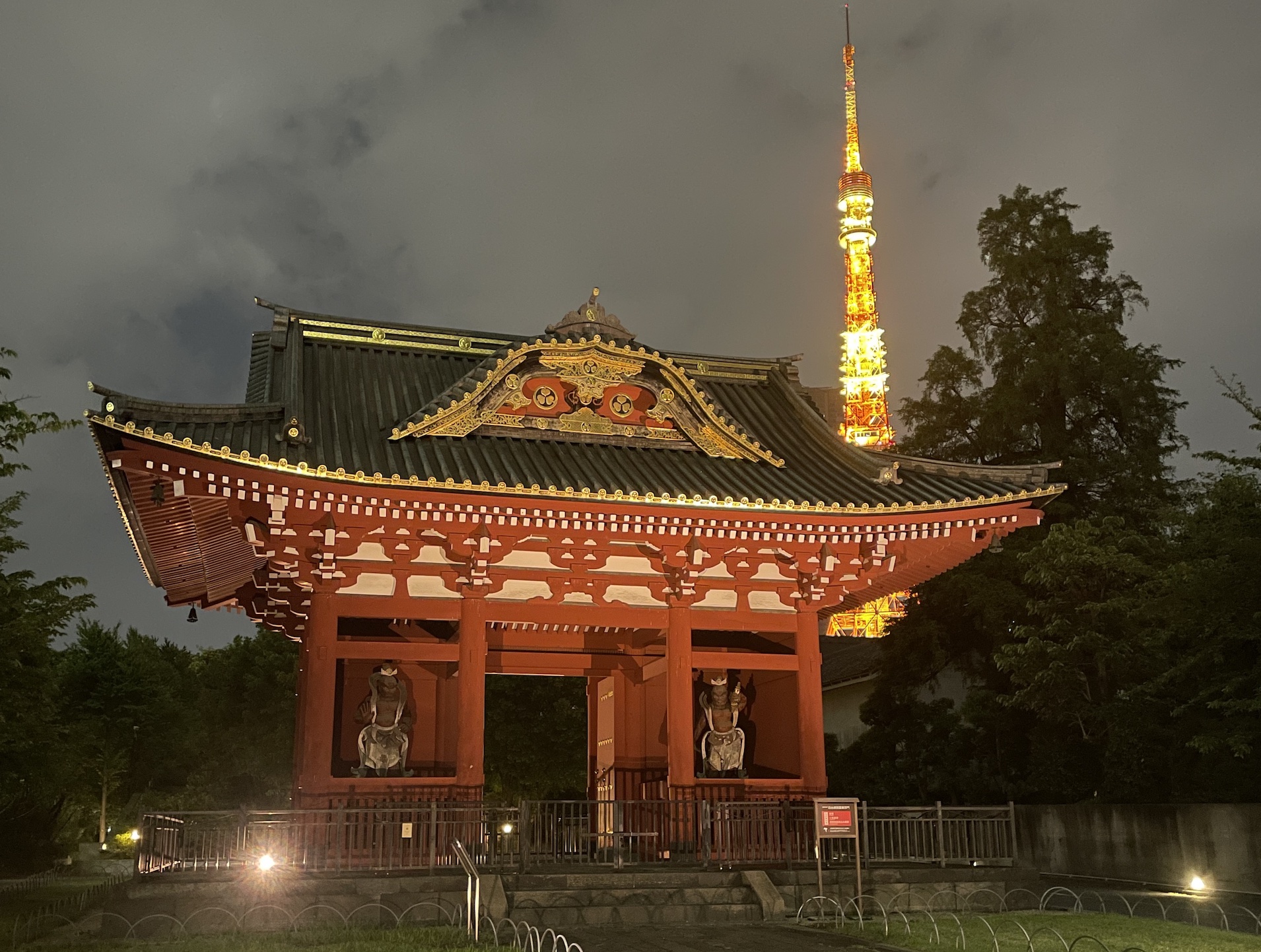
Exploring the Traditions of Japan
Golden temples, vermillion shrines, towering bamboo, sneaky eel—Japan had all that, and more, during my Newman Exploration Travel Award (NEXT) trip in May of 2023. As with so many other plans, my original trip was postponed due to COVID-19, and Japan was one of the last countries to open back up to unaccompanied tourists. But that just gave me extra time to plan, chart, and get excited.
I spent a total of 10 days in Japan, traversing the countryside and cities via its impressive train system. It sounds a little geeky to gush over trains and subways, but this is a relatively small country with a large population (125 million people), and they’ve found an enviable, efficient way to shuttle all those people where they need to go. Navigating around Japan does require a little rule-following, but no one seems to mind. People line up for everything; markings on the floor to tell you where to be. Walk on the left, not the right. I was told, perhaps apocryphally, that tradition was to avoid bumping swords as people passed each other, back in the time of the samurai. Squeeze into that crowded train; it doesn’t matter if your briefcase is lodged in someone’s back; theirs will be in yours. But you’ll get to your destination, and in record time.
And once you’re there, wonders await. Buddhist temples and Shinto shrines were a big draw for this trip, and they didn’t disappoint. First of all, they’re everywhere. In the city, in the country — I was never far from a temple and a shrine no matter where I was. In fact, I stayed overnight in a temple in Tokyo, and the local monk told me the name of the neighborhood was Temple Town because of the large number of temples on every block and street. As a scholar and clinician who works with people with serious illness, I visited the temples to learn more about Japanese spiritual traditions related to dying and death, and I gained a greater appreciation for the complex ways these traditions find their way into the Japanese healthcare system. A second thing to note is that every temple and shrine is majestic. Not necessarily grand in size, but majestic in their beauty, crafted with ornate adornments and statues, painted in rich reds and blacks and golds, meticulous in their well-preserved architectural features and groomed grounds. And third, it was impossible to be in a temple or shrine and not feel a deep calm. Even when the place was smack in the middle of a bustling city, voices quieted, the pace slowed, and stress eased. You knew you were in the presence not only of long history but also something deeply spiritual.
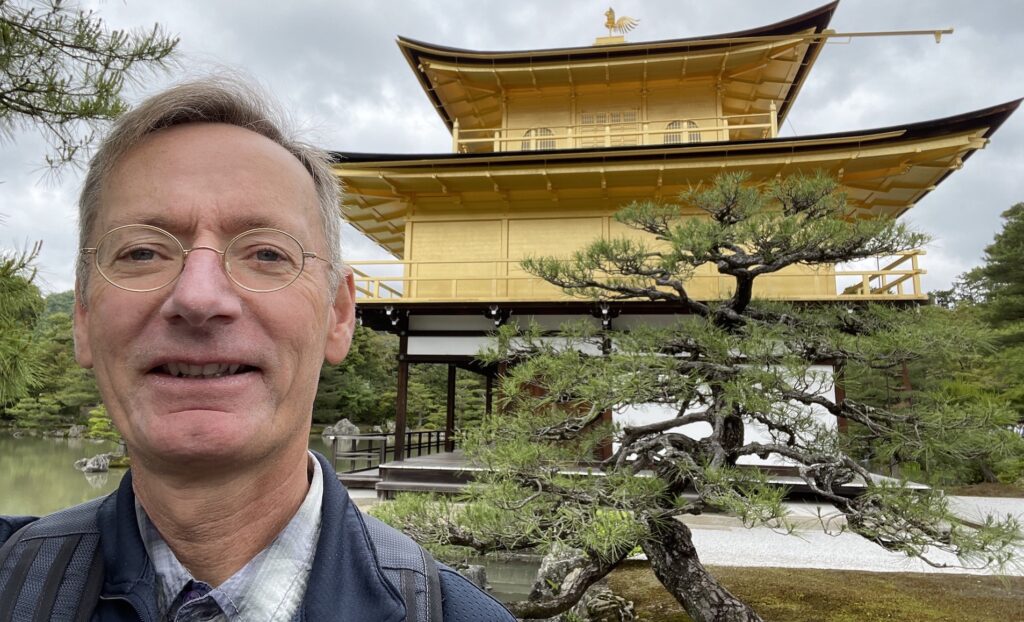
My travels took me first to Kyoto, a 3-hour trip from Tokyo on the gleaming, impossibly fast, and silent shinkansen (bullet train), which at top speed travels nearly 200 miles per hour. My green tea barely wobbled. Three sites in Kyoto, popular with many tourists, topped my list. First was the Kinkakuji Temple, also known as the Golden Pavilion. It’s a two-story zen temple overlooking a placid pond, remarkable because it’s nearly entirely gilded in gold leaf. When the sun hits it just right, the entire crowd oohs, and the selfie sticks come out in force.
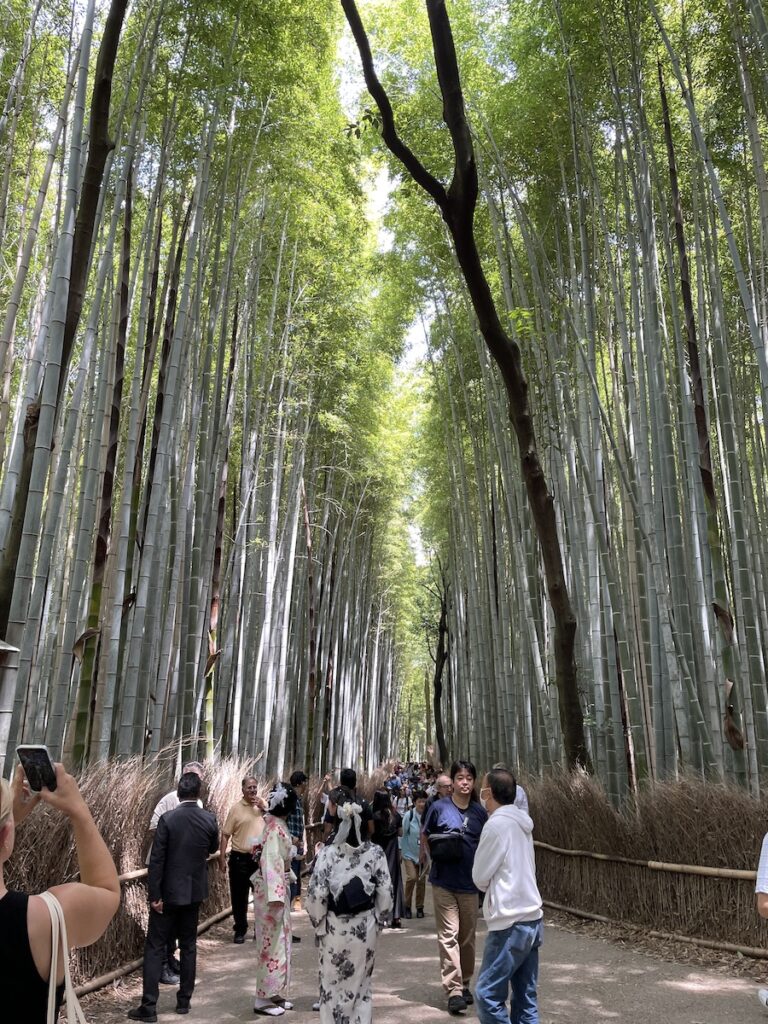
Next up was the equally impressive natural Arishiyama bamboo forest, with its paths winding through thick bamboo trees nearly 90 feet tall, swaying gently in the wind. I expected to look up and see Michelle Yeoh from Crouching Tiger, Hidden Dragon tiptoeing in the canopy. Finally, I visited the Fushimi-Inari-Taisha shrine. Established in 711 AD, the shrine is also made up of many paths lined with hundreds, if not thousands, of brightly painted torii (gates). As you walk through these gates, side paths lead to other “mini-shrines” that feature more gates and many statues, big and small, of fox, the mythical guardian of the shrine. For a fox, their piercing stare communicates a pretty convincing, “Don’t mess with me. Even though I’m made of stone.” All three places were emblematic of Japanese veneration for historical traditions, spiritual depth, and the natural world.
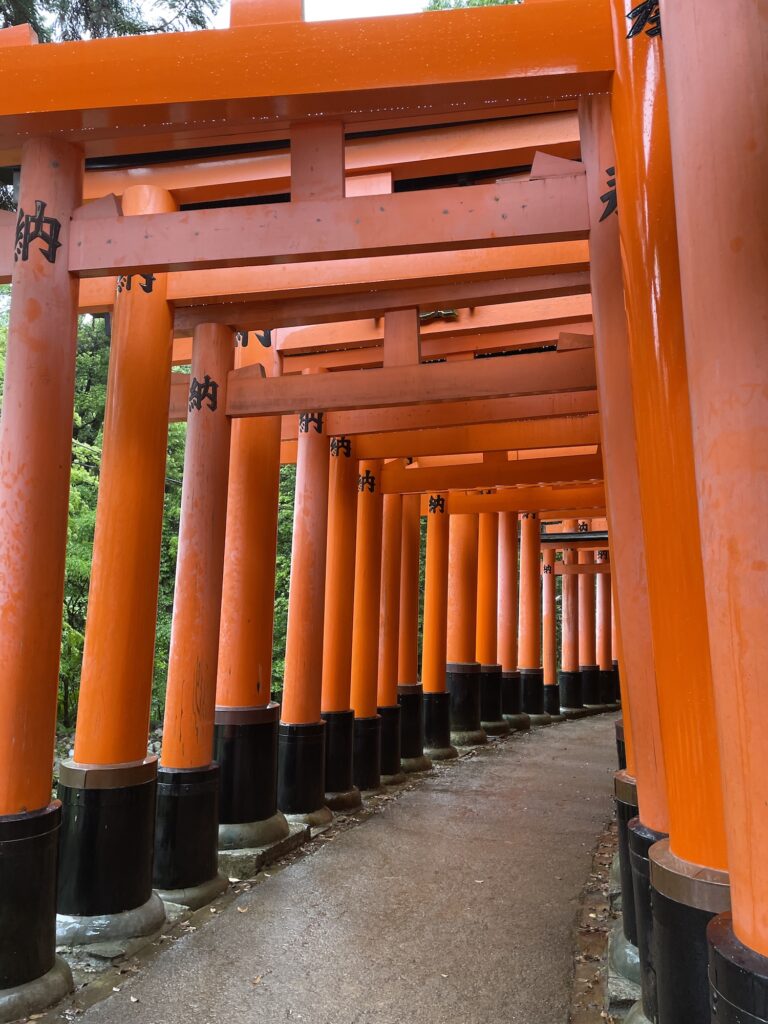
On the advice of my colleague, Professor Lori Watt in the Department of History, my next stop was a smaller city on the west coast, Kanazawa. This town lacked the big ticket draws (and tourists) of Kyoto, but it was spared much of the bombing and destruction during WWII, with old neighborhoods and architecture carefully preserved. One day I enlisted the help of a local guide, Naoko, who led me to sites I would have never found on my own and gave me a running narrative of the city and its history. I learned about geisha and samurai culture, transitions of power over history, and the rich tradition of crafts in Kyoto, known for its gold leaf, glossy lacquerware, and intricate embroidery. On our walk through the local market, I also saw seafood that looked like it came out of a Jules Vern story, capable of pulling me back into the water. But then they grilled it. And I ate it.
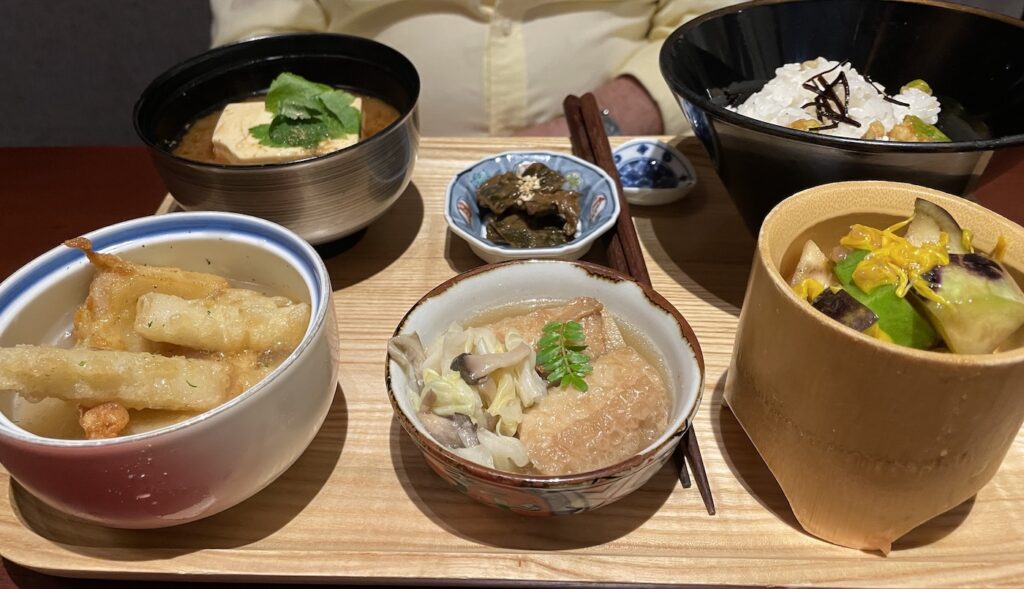
My stay in Kanazawa was at a traditional hotel, with shoji paper screens between rooms, tatami mats made of grass, and a futon on the floor. (I was reminded, painfully, that I’m not as young as I used to be when I tried to get up off the floor in the morning.) The highlight in the hotel was the onsen (hot spring) where people could bathe and soak throughout the day. Nothing gets you ready for sleep after a day of urban traipsing than a 15-minute soak in coffee-colored, mineral-rich warm water. Another highlight of the hotel was the breakfast buffet, which featured, among other things, grilled rosy seabass, homemade tofu in delicate bamboo cups, seitan and whelk (snail) stew, and lotus root. They also had shokupan, square Japanese milk bread, which made an excellent toast to go with the strong tea. Here again, the buffet was a carefully crafted display, elegant and impressive, designed to showcase the gastronomic traditions of the region.
Before taking my next, and last, bullet train ride from Kanazawa to Tokyo, I discovered that at the train station, I could purchase a bento box filled with a selection of small snacks—pickled daikon, bean curd, gluten cakes, yam, a fish cake, rice, and eel that snuck in disguised as a fried cake. (You should be sensing a food theme to this trip by now.)

So, Tokyo. Where do I begin? It’s got nearly 14 million people, spread out over incredibly diverse neighborhoods, that contain architecture both wildly modern and devotedly traditional. While walking around Tokyo’s diverse neighborhoods, the action at street level is only a thin slice of what’s going on. Shops, restaurants, and bars are organized vertically too, so you have to look up, not just ahead. In addition to more temples and shrines, my goal for this stop was to visit some architectural highlights and museums. Public spaces showcased incredible construction, gleaming arches, and glass and soaring high-rise buildings. One clear evening, I went to the top of the Tokyo Skytree, a broadcasting and observational tower that was until 2011 the tallest structure in the world. I got a great view of the glittering city, with a new appreciation for its crisscrossing rivers, parks, and neighborhoods. Back on the ground over the next few days, I visited museums that featured Japanese history, painting, glass, fashion, and design. This is a culture that reveres beauty, and that’s evident all around, from the delicate bonsai trees to the meticulous meal presentation to the fashion on the street.
When I returned to the United States I had complex feelings, as I suppose all good travel experiences yield. I was glad to be home. It felt good to do laundry. It felt good to have a peanut butter and jelly sandwich. But I also missed being out of my routine. I missed planning my day with my guidebooks and web searching. I missed feeling disoriented, not sure what the custom was, not sure where I was going, not sure how to mime that thing I needed, not even sure what I was eating sometimes. (That’s you, eel.) I have great admiration for Japanese culture, and I feel fortunate to have had the opportunity to see it in so many different facets. There are some things I found frustrating there if I’m honest, but some things I admire and wish I saw more often here—respect for other people, an appreciation for craft and artistry, the acknowledgment of the importance of history, the veneration of nature. How often do we get the opportunity to be so completely disoriented? Not enough, I think. And so, I’m grateful for the disorientation the NEXT Award gave me this summer.
I also appreciate the opportunity this trip gave me to reflect on my teaching and scholarship and think about how I can incorporate Japanese perspectives and ideas into my research and courses. As I return to campus, I’m already thinking about how to extend my research into end-of-life care to examine a wider range of interventions to address psychological distress in patients with serious illness. Similarly, in my classes, I’m developing new activities to encourage a more global perspective on aging and palliative care. So in the end, I hope I can share the gifts of this travel experience with the larger WashU community and beyond.

